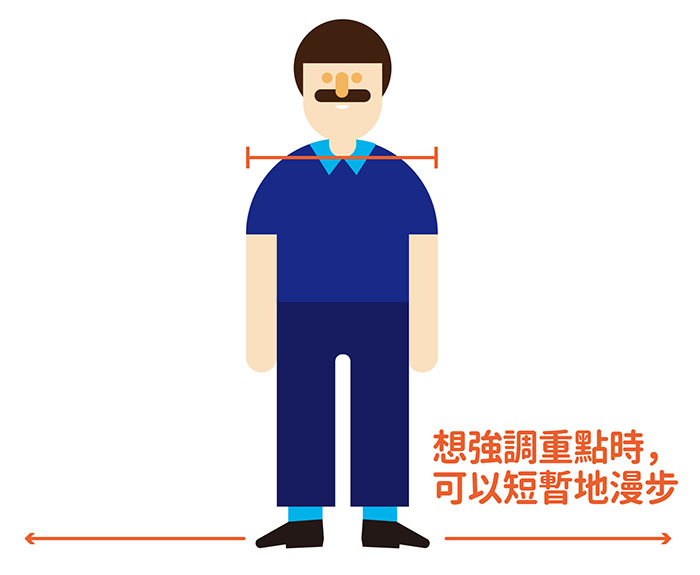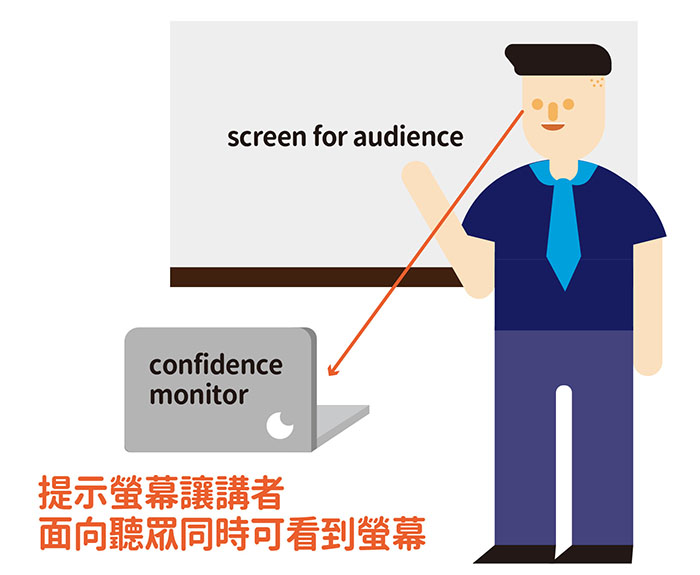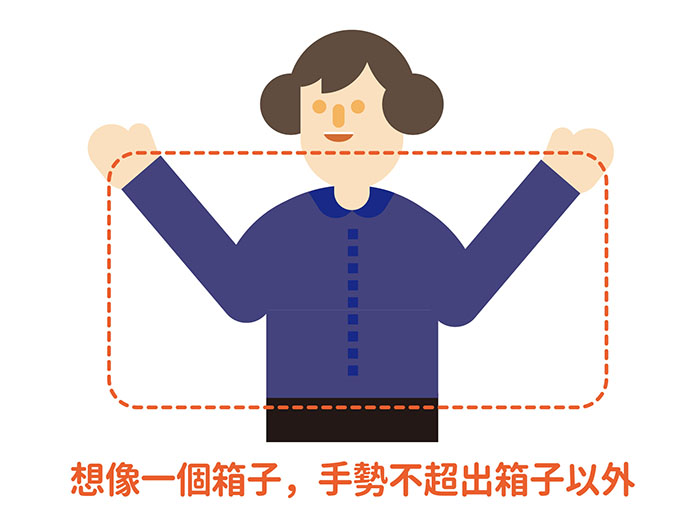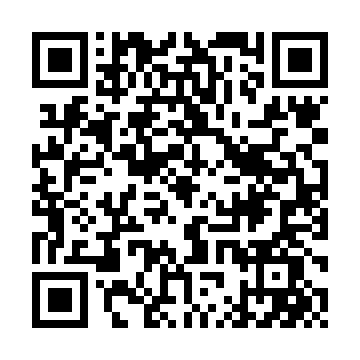
藏在肢體語言背後的說服力
專業老師教你說服技巧 ▶請點這裡
進入本文前,想想以下單字英文怎麼說: (A) 漫步 (B) 傾斜 (C) 扣緊
When making a presentation, one of the most important things to practice and put into action is your body language.
1. The Back
A hunched posture, with the head low and back bent, is always going to give off a submissive and low-energy feeling. Stand with your back straight and your head high, eyes ahead. It will both radiate vitality to your audience, but more importantly make you feel better about what you're saying.
弓著背垂著頭的蜷縮姿勢,散發順 從和低能量的感覺。背打直頭抬 高,目光向前看,這樣的姿勢給觀 眾帶來活力,更重要的是你會對自 己說的話感覺更好。
2. The Feet

When standing, keep them roughly shoulder-width apart and firmly planted on the ground. But when you want to punctuate a point, feel free to go for a brief (A) stroll around the room, keeping your attention on the audience without interrupting your speech.
站立時腳掌與肩同寬站穩。但想強調重點時,可以短暫地漫步,同時保持對聽眾的注意力、不中斷演說。
3. The Head
A (B) tilt of the head to the side is both an inviting and submissive pose, but in a presentation this can be used to either punctuate a (often rhetorical) question, or invite an actual answer from the audience. Historically this is because the neck is a vulnerable area, and revealing it shows trust in the other party. When taking questions from the audience, we register this pose as much more open, accepting and friendly than coldly staring someone down.
頭側到一邊表示誘惑和順從,不過簡報中對觀眾提出問題時,可以這樣做以強調問題,或表示請聽眾回答。脖 子是脆弱區域,露出脖子顯示對對方的信任。當聽眾發問,側頭也可顯現你對問題持開放、接受態度,比面無 表情直盯著發問者好。
4. The Hands

Keeping your hands visible if behind a lectern appears more trustworthy, with nothing shady or "under the table". Facing your palms up appears open and positive. Make sure not to (C) clasp your hands in front of you, closing yourself off from the audience, but don't exaggerate too wildly: flailing around onstage will only distract from your message. Keep your gesturing inside an imaginary "box" around your torso (1) so as to keep your audience's attention on you.
如果是站在講台後,雙手放在聽眾看得見的地方,會提高可信度。掌心朝上、朝外給人開放和積極的感覺。不要緊扣雙手,這樣感覺像對觀眾關閉自己。也別過度誇張了,一直揮舞雙手只會分散你的訊息。最好的方式是保持手勢在一個虛構的「箱子」內,觀眾的注意力就不會遠離你。
5. Focus

Keep your body, face, and attention towards the audience. A presenter reading from the screen is completely pointless and boring to watch. If you do feel the need to check up on your notes, consider using a small monitor for confidence to prompt you at times when you draw a blank. Also, direct your points to specific members of the audience: with individuals we can establish a real connection multiple times over the course of a speech. Use your gaze to (2) reel them in, one by one, and the rest will follow.
保持你的身體,臉,注意力都在觀眾身上。面向螢幕唸出投影片既沒意義又令人無聊。如果有需要核對你的講義,可以考慮架設在前方的小型螢幕(如圖)。同時,與特定聽眾互動,建立一對一的連結--簡報進行中,與不同的人單獨對視、互 動,你會發現其餘聽眾也開始跟隨 他們的舉動。
6. Timing screen for audience
Your tempo when giving a speech is a clear indicator of confidence. A speaker that rushes through a presentation, cycling through slides at (3) breakneck pace, comes across like a panicked rabbit. Don't be afraid of silence. A pause can let an important point sink in, but most importantly it shows confidence in being on stage; not trembling in the headlights.
人的說話節奏反映自信程度。想匆匆講完、快速切換投影片的講者,讓人聯想到驚慌的小兔子。不要害怕沉默,短暫停頓可以讓人充份理解你的重點,更重要的是,這會展現你在台上的氣度。
延伸片語
1. So as to 為了…;以便於…
I leaned in so as to hear more clearly.
我身體往前,以便聽得更清楚。
2. Reel sb. In 收線、捲線
David reeled in the first fish. David
收線掉起第一條魚。
3. Breakneck 極快;極危險的
He drove to the airport at breakneck speed.
他向機場疾駛。
專業老師教你說服技巧 ▶請點這裡
文/Nikki Lu
插圖/林昕慧
本文收錄於英語島English Island 2017年10月號
訂閱雜誌
| 加入Line好友 |  |

 擔心生理健康,心理卻出問題?
擔心生理健康,心理卻出問題?